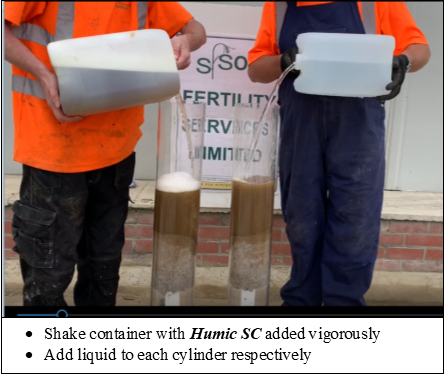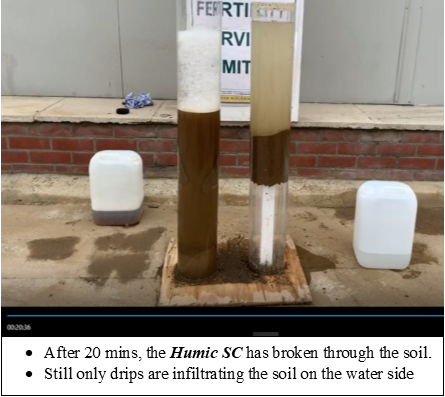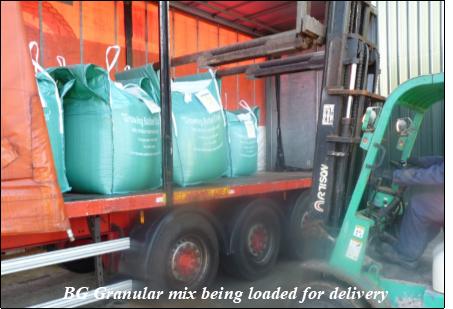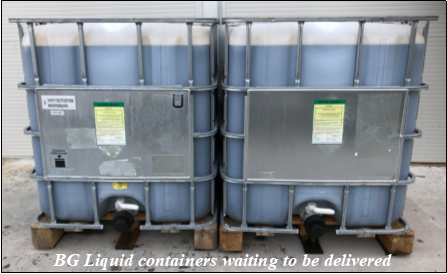IN OR OUT - LIFE GOES ON
- Soil Fertility Services

- Oct 23, 2019
- 8 min read
Updated: Mar 30, 2023
IN OR OUT - LIFE GOES ON
2019 has been a roller coaster of a year for many of us with a very dry winter and baking hot summer; more grass than some of you know what to do with; better than expected cereal crops; prices are under pressure with beef animals making less than the cost of production and who knows what is around the corner.
We keep moving forward with the ‘Biological approach’ to soil and crop health, it’s not 100% success but then what is? The Vita-Protect seems to have done it’s job again, the nitrogen fixers have worked producing similar yields as conventional nitrogen inputs but at a much lower cost and NO carbon footprint - (well not much but we do have delivery inputs).

Plant growth stimulants appear to have worked to produce healthy plants that need little or no fungicide and the phosphate fixers have kept crops high in sugar with good rooting. Now the rain!!!
Humic SC
Did you get Humic SC on? This is one of our most long-lived products, preventing bound water and improving water infiltration. Your drainage water should be clear enough to drink. Humic SC has a strong negative charge that pushes the clay colloids apart, thereby reducing the ability to trap water.
With the Humic/fulvic compound there is a good food source for the soil, when you think about it, just one kilo of Humate is equivalent to 10,000kg of straw in terms of contributing to soil humus levels; organic matter may be important but it is humus that is essential, it is the only thing on the planet that microbes actually build, everything else they breakdown – your car/tractor both will be broken down given time, back to elemental form; only organic matter is reformed into humus.
Our guys in ‘Production’ decided to do a basic test of the Humic SC product just in the yard. It took a while and although it isn’t very ‘scientific’ the results showed exactly what we already knew, the difference being we can now show you guys, that what we have been saying is true. You can see the video of the test although it takes 20 minutes of listening to some rather boring music but this is the link:
You’ll have to ring in for any other info: 01366 384899
It was back in 1995 that I was first introduced to Biological Farming following 30 years in the conventional fertiliser industry. It was Neal Kinsey that opened my eyes to the alternatives and introduced me to ‘Agri SC’ - 24 years to an overnight success! We have many customers that use Humic SC every year (developed from Agri SC). The fact is it improves air space in the soil, the consequence of which is that you can access more of your FREE nitrogen!
When you work it out, there is 75,000kg of nitrogen above every hectare and around 5,000kg in your soil; surely we can get enough of it made ‘plant available’ to grow your crops with little or no nitrogen fertiliser needed. Bio-N is the key to ‘unlock’ this never-ending supply and NO carbon footprint. The key factor is the spaces in the top soil, it can only happen if you do have the air spaces, plus soil temperature above 8◦ and a food source ie your plant root exudates and especially if your crop has had an application of Vitaplex V8 (the V8 provides the essential minerals that will improve the quality of the plant root secretion to the beneficial micro-organisms).
BetterGrass
BetterGrass continues to do exactly as it says: simply helps you to grow better quality grass! Grass that stock find palatable and that has the essential minerals in balance for optimal animal health:
Iodine:
Effects the thyroid function, body temperature control keeping animals warm when it is cold, and cool when it is hot.
Affects the function of lactation muscles and is important in the development of the foetus. 80% of the animal’s iodine requirement is absorbed by the rumen.
Critical for stock health and compulsory for forage inclusion.
Cobalt:
Essential for all ruminant animals
Source of vitamin B12; required to control the energy for the rumen and the animal, and is best absorbed from the grass forage
Essential for efficient function of the rumen
Selenium:
Required by humans and animals for preventing:
Reproductive failure
Retained placenta
Immune suppression
White muscle disease
By far the best source of selenium is from the forage. It SHOULD be in your grass. All minerals are essential but they MUST be in balance; too much of any one will cause a deficiency of another ie;
Too much potassium – A deficiency of magnesium and create Hypomagnesaemia.
Too much sulphur – A deficiency in copper
Too much molybdenum – A deficiency in copper
That is what makes The BetterGrass Program so good, we analyse both your soil and your grass but just bear in mind:
Your soil analysis DOES NOT tell you what is in your grass,
Your grass analysis DOES NOT tell you what is in your soil.
We need them both; the soil mineral levels may affect structure, air space, and biological activity, which in turn will affect mineral uptake. You can have a truck load of essential minerals in your soil but your crops may be deficient. We don’t need to add more, we just need to improve the ‘availability’.
The ‘New’ BetterGrass Liquid formula has been well received, it is easy to apply and especially with the mini sprayers. At only 50 lt/ha you can easily spray it yourself, BUT YOU MUST ACTUALLY DO IT! A few of you didn’t manage to get the product on, you’re “Too busy”. That is just crazy! If you’re too busy, then get someone else to do it. It isn’t doing either you or your stock any good sitting in your shed.

One of the main benefits of moving to the BetterGrass Liquid product is to allow us to include the ‘biologicals’, the beneficial micro-organisms that have specific functions in your soil and plant health, ie phosphate fixing Megatarium or pH modifying bacteria for acidic soils, plus of course the nitrogen fixing bacteria. The results are similar to the dry product, speaking of which, these are still available so you now have a choice.
Analysis anomalies are not always bad...

Mr E. Gibbons from Holyhead, Anglesey has been a BetterGrass customer for ten years now, the examples below show the results of the initial silage sample taken from the silage that he was feeding his stock, compared to the grass sample taken this year showing the grass the stock are now eating. The mineral levels are now not only higher so producing much healthier stock but are also much more balanced.
The soil samples are also taken from the same field and show that although they are taken 8 years apart, the pH has dropped slightly in the soil, the calcium level in the plant is higher - as are most minerals in this well-balanced grass.

Arable
Arable crop yields have been pretty satisfactory with reasonable prices - hopefully you have made a profit but too many of you have very high production costs.
The object of the biological approach is to lower this cost; little or no fungicide, less than half normal nitrogen and NO autumn fertilisers could make savings of over £100/ha.
On farm trials with the biologicals do not show increased yields - we never thought they would, but they do show similar yields at a lower cost of production plus year on year soil health improvements. The beneficial soil bacteria act just like a probiotic protecting your crop from soilborne disease and releasing ‘locked-up’ minerals from your soil.
What is a Beneficial Microbe? - Steve Holloway
Soil contains many different lifeforms, many are considered beneficial because they are recycling/ decomposing soil organic matter, releasing locked up nutrients and minerals that would otherwise be unavailable to the plant root network. Plants will attract these beneficial microbes with their sugary secretions (exudates) in exchange for this cocktail of nutrients, So what does the plant need first? Energy ...
… In the form of Phosphorus, a vital element of ATP, the "energy " of plants, phosphorus is especially important for the plant’s general health and vigour, the more roots you have the better equipped the plant is to scavenge from the soil. Phosphorus (P) is needed for seed germination and early root growth, so how can you help to facilitate this relationship? After all a root will initially only have access to the soil it makes contact with, imagine It is a bit like a hungry baby. At first it will eat whatever is within arm’s length then if that’s not satisfying the appetite it starts crying out to be fed and who should be listening? the soil microbes in the root zone.
One such soldier to the rescue is Megatarium that actively looks to break down the bonds that phosphate has with other elements within the soil thus allowing the plant to utilise the (P) with the bonus that this Bacillus can also release atmospheric nitrogen in the process. ‘The Rhizosphere? (root zone) Is the area of soil that is directly affected by a plant’s root system.’ Here the bacteria are in abundance, all clambering for a seat at the dinner table desperate to get a piece of the exudate action. The plant is fully away of its own requirements and as such will selectively attract soil microbes and feed them accordingly creating a feast for the microorganisms.
Potassium (K) There is a pretty good chance that your soils are chocked full of potash’ (Potassium) essential in nearly all processes to sustain plant growth and reproduction. When this is deficient plants are less drought resistant, more susceptible to excess water and extreme temperatures with increased vulnerability to pests and disease attacks. Potassium improves the general health of growing plants and aids them to fight diseases, affecting quality aspects such as size, shape, colour and vigour of the seed or grain. Remembering that just because it is in your soil it may not necessarily be available to the plant, that is the job of Bacillus bacteria like Mucilaginous that aids the release of soil potassium, phosphorus and silicon and fixes nitrogen in exchange for sugars from the plant roots. You need to apply Beneficial’s to actually receive their benefits, so many bacteria, so little time, as Richard Branson says” Screw it! just do it!”
Steve
Life In The Soil

The Man Shed - Robert Plumb
On the personal front...
It is over a year since our daughter Nichola was admitted to hospital with a stroke and just coming up to a year since we brought her home having been advised she had only 6 weeks or so to live.
Nichola is still with us and we are still all fighting to keep her with us. I believe nutrition has been the key to her continued improved health. As I have mentioned before, she has suffered from severe rheumatoid arthritis since the age of 2yrs and now has an ovarian cyst the size of a football. It is this that is causing her constant pain, pressing on all her internal organs. We are now fighting to have this removed as it should have been 2 years ago but unfortunately wasn’t.
Can she survive the operation? We are really not sure, but she will not live for much longer unless it is removed - Catch 22. If we can get the cyst removed, we will be able to get Nichola into a wheelchair and she can say Hi to the world once again. So, the constant battle with the medical Professionals has severely restricted my movements; I need to be there to support her mum Annie, and to help with her medication and nutrition (home-made juices and smoothies with probiotics added), so the ‘Man Shed’ is a bit lacking in men right now. However, I can still grumble at the radio and occasionally the TV news – What about the antics of our ‘leaders’? We should sack the lot of them.
Aunt Aggie was right when she said:
“Tha’s no good putting yur foot down if yur hint got a leg to stand on.”
I will get to our local events – East of England Show, Croptec, Cereals and maybe the 2020 Grassland event so I look forward to seeing you there.
Robert
Newsletter Issue. 59












Comments